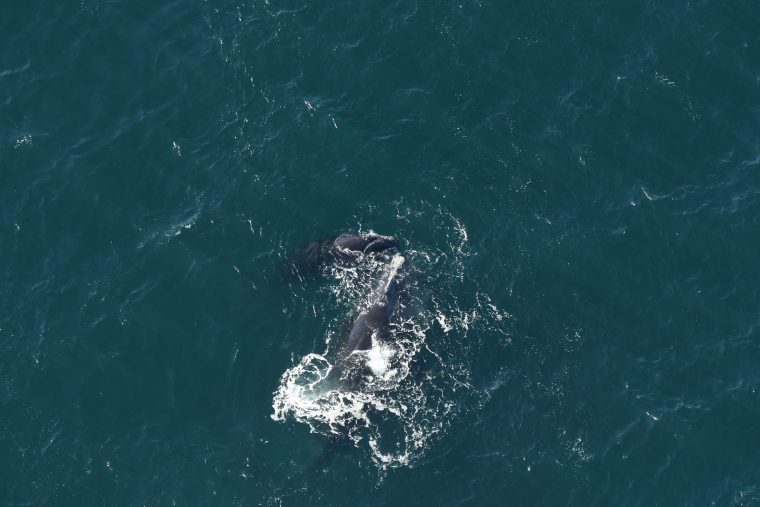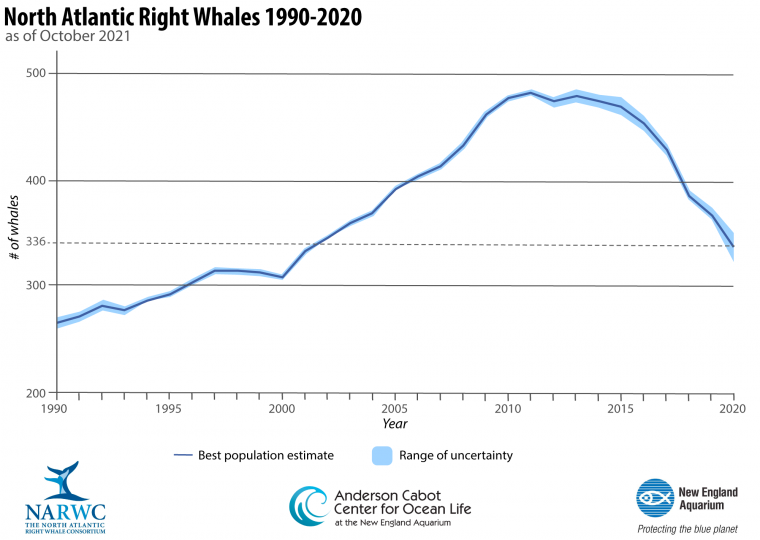The Aquarium will be closed to the public on Wednesday, April 2, for an internal staff event. Regular operating hours will resume on April 3.
Newly released estimate for critically endangered species is lowest number in nearly 20 years

BOSTON, MASS. (Oct. 25, 2021) – In another sign of the critically endangered species’ decline, the North Atlantic Right Whale Consortium announced that the North Atlantic right whale population dropped to 336 in 2020, an eight percent decrease from 2019.
The latest estimate, which comes ahead of the Consortium’s annual meeting, is down from 366 in 2019. Notably, the population estimate is the lowest number for the species in nearly 20 years.
“We are obviously discouraged by this estimate, but quite frankly, not surprised. The right whale research and conservation communities know that while widespread efforts to change the trajectory of the species have been undertaken, they have not been enough,” said Heather Pettis, associate scientist in the New England Aquarium’s Anderson Cabot Center for Ocean Life and executive administrator of the Consortium.
North Atlantic right whales have been on a downward trajectory since 2011, when the species was at its highest estimate of 481 whales. In the past 10 years, the species has declined by 30%. Human impacts, specifically entanglements in fixed fishing gear and vessel strikes, remain the biggest threats to the survival of this species. Recent research shows that body lengths of right whales have been decreasing over the past four decades, with life-threatening entanglements leaving individual animals with less energy to devote toward growth and reproduction. New England Aquarium research has also shown that 86% of identified right whales have been entangled one or more times in fishing gear.
“There is no question that human activities are driving this species toward extinction. There is also no question that North Atlantic right whales are an incredibly resilient species. No one engaged in right whale work believes that the species cannot recover from this. They absolutely can, if we stop killing them and allow them to allocate energy to finding food, mates, and habitats that aren’t marred with deadly obstacles,” said Dr. Scott Kraus, chair of the Consortium.

The North Atlantic Right Whale Consortium meeting, which is being held virtually October 26-27, will also be releasing reports on whale births and deaths. In 2021, scientists tracked 18 mother-calf pairs, a number that is cause for optimism yet well below the annual average of 23 pairs from the previous decade. Additionally, there were two documented mortalities in 2021. The 2021 male calf of “Infinity” (Catalog #3230) was struck by a recreational fishing boat in the calving grounds off the Florida coast on February 12 and died soon after. Just days later, 11-year-old adult male “Cottontail” (Catalog #3920) was found dead off Myrtle Beach, SC, after being sighted entangled and emaciated. While the relatively low number of mortalities is encouraging, research has shown that just 36% of mortalities are actually detected—with known deaths representing a fraction of the true death toll.
“The combination of fewer detected deaths and an increase in births provides some rare good news for this species. We estimate there are less than 100 breeding females remaining. Let’s hope that calving continues to improve with many more positive years ahead if we are to reverse the species’ downturn,” said Philip Hamilton, senior scientist at the New England Aquarium and the Identification Database curator for the Consortium.
Collaborative efforts to reduce the lethal and sub-lethal impacts of human-caused threats to North Atlantic right whales have involved conservationists, scientists, government agencies, and the fishing and shipping industries. Yet despite these significant measures, saving this species from extinction will require bolder, more decisive and immediate action. History has shown right whales are a resilient species that can recover if humans provide an ocean habitat suitable for these whales to thrive.
“We as humans have put these whales in the predicament they are in, and we have the ability to help them out of it. Broad collaboration and a long-term commitment to ensuring this species’ survival is required and urgent actions to prevent entanglements and collisions with vessels must be implemented,” Pettis said.
The North Atlantic Right Whale Consortium, which was co-founded in 1986 by the New England Aquarium and partners from the University of Rhode Island, the Center for Coastal Studies, Marineland of Florida, and Woods Hole Oceanographic Institution, formed as a means for right whale researchers to collaborate and share data in order to understand and protect the species. Today, the group consists of 200 individuals, organizations, industry representatives, and government agencies from the United States and Canada who are engaged in right whale conservation efforts. The Consortium is holding its annual meeting this week with nearly 500 attendees from the U.S., Canada, Europe, and Australia expected. Participants have access to 52 presentations in areas ranging from health and physiology to human impacts and federal management efforts.
MEDIA CONTACT:
Pam Bechtold Snyder – psnyder@neaq.org, 617-686-5068
